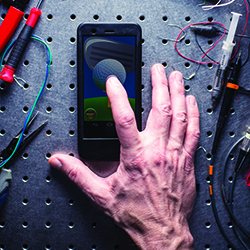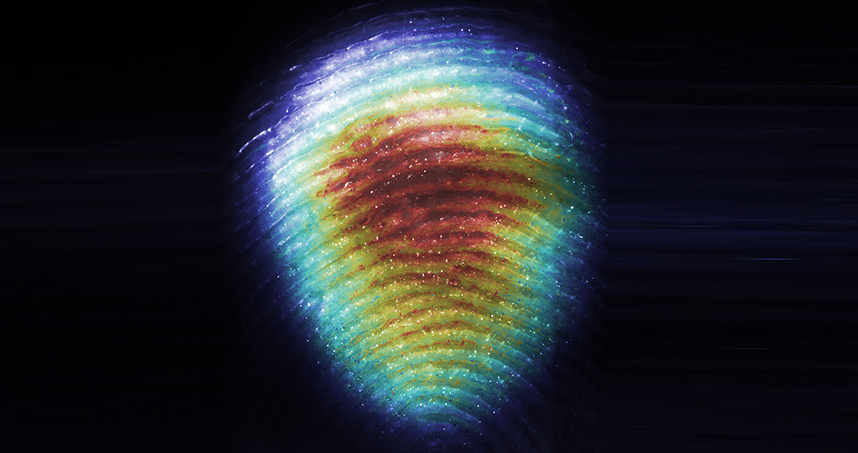Mystery Solved: The Case of the Slipping Finger
Ultrasonic vibrations cause fingers to bounce on touchscreens, reducing the friction
Haptics researchers have long known that applying ultrasonic vibrations to a flat, featureless glass plate makes it feel slippery. But they have also long debated why this occurs.
Northwestern Engineering’s J. Edward Colgate and his team have finally put the debate — and mystery — to rest. They discovered that the vibrations reduce friction by causing the fingertip to bounce on pockets of trapped air.
 “Understanding this underlying reason is extremely useful,” said Colgate, professor of mechanical engineering and Allen K. and Johnnie Cordell Breed Senior Professor in Design. “This information will help us engineer more sophisticated devices that not only vary friction but do other things, such as exert forces on the finger.”
“Understanding this underlying reason is extremely useful,” said Colgate, professor of mechanical engineering and Allen K. and Johnnie Cordell Breed Senior Professor in Design. “This information will help us engineer more sophisticated devices that not only vary friction but do other things, such as exert forces on the finger.”
Supported by the National Science Foundation, the research was published on August 1 in the Proceedings of the National Academy of Sciences. Michaël Wiertlewski, a former postdoctoral fellow in Colgate’s laboratory and research scientist at Aix-Marseille Université in France, was first author of the paper. Rebecca Fenton Friesen, a PhD student in Colgate’s laboratory, also contributed to the work.
A haptics technology pioneer, Colgate aims to redefine the way users interact with their touchscreens. With long-time collaborator Michael Peshkin, professor of mechanical engineering at Northwestern, Colgate and his team created the TPad phone, a standard smartphone nestled in a case that enables physical textures to be communicated through the screen. Ultrasonic vibrations in the glass modulate the friction between it and the finger, causing the screen to feel sticky, slippery, bumpy, or wavy.
The lack of understanding of the underlying mechanism that makes the screen feel slippery posed a barrier to furthering the research. Earlier studies showed that when objects, such as metal discs, were placed on a vibrating screen, they floated above it. But haptics researchers were hesitant to apply these findings to a finger.
“Fingers are different than what has been used in other studies,” Colgate said. “They’re not hard or rigid, and they’re rough because of the fingerprint and build up of dead skin cells. We’ve been trying to understand this phenomenon for a number of years, but the kind of instruments we needed weren’t available.”
 Wiertlewski overcame this hurdle by building an apparatus to image the finger as it experiences the ultrasonic vibrations. He built a novel fingerprint imager — a high-tech cousin of the kinds used in security — and connected it to a TPad. This allowed the research team to see through the transparent screen of the TPad to watch the finger fast enough to make measurements of the distance between the screen and finger at the time scale of the ultrasonic vibration.
Wiertlewski overcame this hurdle by building an apparatus to image the finger as it experiences the ultrasonic vibrations. He built a novel fingerprint imager — a high-tech cousin of the kinds used in security — and connected it to a TPad. This allowed the research team to see through the transparent screen of the TPad to watch the finger fast enough to make measurements of the distance between the screen and finger at the time scale of the ultrasonic vibration.
“We saw the skin moving — a lot,” Colgate said. “It’s vibrating with almost as much amplitude as the TPad itself, but it’s happening too fast to feel it.”
The finger bounces so quickly, in fact, that the air trapped between it and the screen has no time to escape. Instead, the air compresses and acts like a spring. The vibrations push the finger up into the air, and as the finger comes back down, it falls onto a cushion of air instead of the screen. The process reduces friction and emulates the feeling of slipperiness.
“We saw other types of objects floating,” Colgate said. “By no means is the finger floating. It’s bouncing.”
Colgate believes that having this information will help his team pursue one of haptics’ biggest challenges: using vibrations to push a bare finger. This effect could be used, for example, to push the fingers to align them over a keyboard, which could be useful for people who are blind, have low vision, or are in situations where they cannot use their eyes, such as when driving or in the dark. While Colgate’s team has achieved this effect in the laboratory, the force has not been as strong as they would like. They know why — the screen cannot effectively grab the fingers when the vibrations have reduced friction.
“Almost anything you do on a touchscreen could be influenced by this finding,” Colgate said. “We can do more interesting things with the TPad and develop future technologies.”
